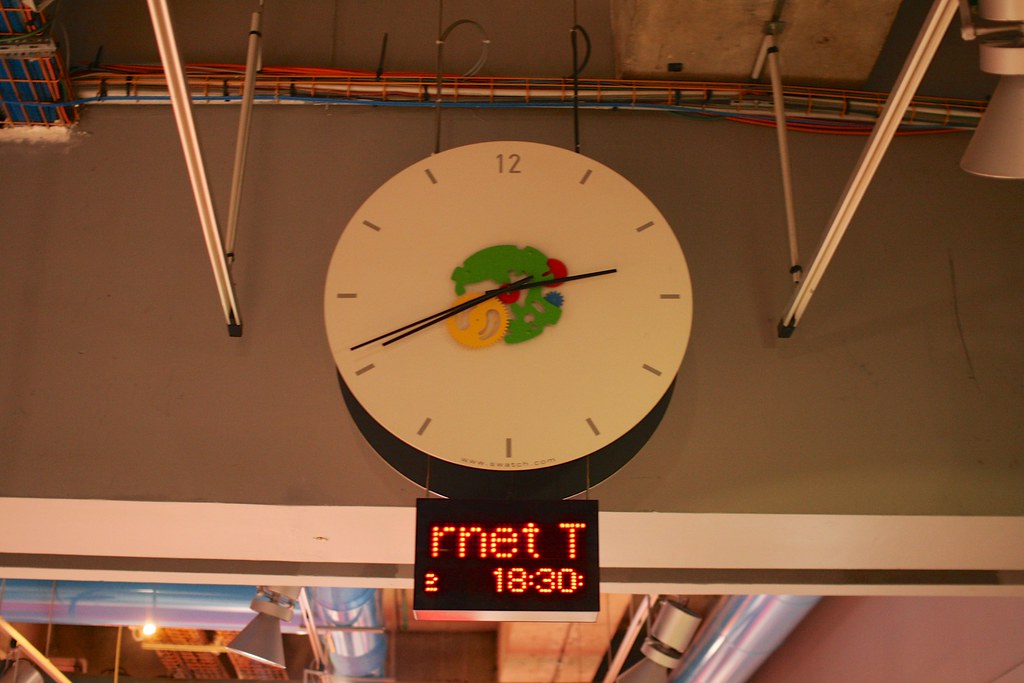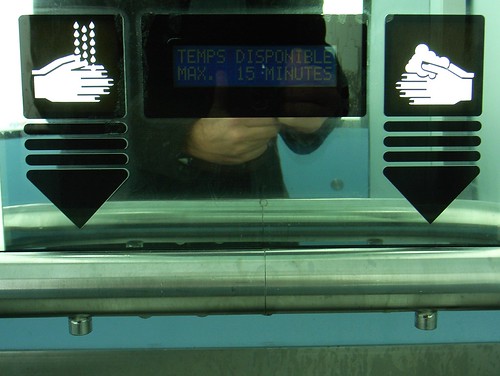 If you enter Centre Georges Pompidou, a cultural complex in the 4th arrondissement of Paris, and you wander around the basement, you may run across the clock represented on the right. The device looks rather standard, except for the colorful cogs, perhaps shown here as an echo of the high-tech architecture of the whole building. Another oddity you might notice is the LED display which gives a digital indication of the time, and a mysterious 3 digit number next to an "at" symbol.
If you enter Centre Georges Pompidou, a cultural complex in the 4th arrondissement of Paris, and you wander around the basement, you may run across the clock represented on the right. The device looks rather standard, except for the colorful cogs, perhaps shown here as an echo of the high-tech architecture of the whole building. Another oddity you might notice is the LED display which gives a digital indication of the time, and a mysterious 3 digit number next to an "at" symbol.
This combination ("@ 452") corresponds to a new way to display time, envisioned by Swatch, a Swiss watch company. The idea was to divide up the mean solar day up into 1000 parts called ".beats" (which means that a ".beat" last 26.4 seconds). Each day begins at @000 .beats, which actually corresponds to midnight in Switzerland (CET: Central European Time) and the Internet noon is thus @500 (3am in San Francisco, 6am in New York). This simply means there are no time zones, and only time scale called "Biel Mean Time" (BMT), based on the city where the company's headquarters are located.
Besides this big clock, one may find such .beats on Swatch watches as well certain cell phone models, a video game and Linux GUIs. Apart from the company website, this "new" time display is now quite uncommon, but it should not prevent us to wonder about its origin as well as its cultural implications.

According to the Wall Street Journal, the Swiss company first presented the idea for "Internet Time" back in 1998 at the MIT Medialab's Junior Summit:
"The gathering of more than ninety children aged 10 to 16 from 54 countries was organized to discuss technology's impact on the younger generation. Swatch is a major sponsor of the Lab and has been for about five years. The idea was that far-flung people would use Internet Time to coordinate their schedules and socializing"
Also, this new time standard was supposed to be used for the Nation.1 project, a conceptual country based on the Internet and owned, populated and governed by the children of the world (!).
Aside from this intriguing origin, this "internet time" based on .beats is interesting from a cultural perspective for various reasons.
First, it is important to frame this project as one of the many initiatives to measure and manage time. Over the course of history, scientific and technical discoveries have led to the design of curious apparatuses to display the "passage of time". Think about how sand, oil, candles, ropes, sticks, mechanical pieces or nuclear technologies have enabled this. It's thus not surprising to see "the Internet" as part of an assemblage devoted to measuring time. However, unlike the usage of sand or oil to measure time, the idea here is not to use the technology (network infrastructure). The point is, instead, to benefit from the sort of temporal synchronicity created by the usage of internet platforms (email, Web, etc.) and claim the importance to live in a similar timeframe. Swatch internet time was meant to get rid of time differences and have a common reference. Said differently, it's as if the Swiss company had declared local time and place irrelevant. This is all good and nice except for a fact: the "origin" .beat (@ 000) corresponds to where their headquarters are located, which is not exactly very egalitarian.
Nevertheless, even if this "internet time" sounds curious and may have looked cool, this new time format suffered from path-dependence: " how the set of decisions one faces for any given circumstance is limited by the decisions one has made in the past, even though past circumstances may no longer be relevant". This phenomenon seems always an issue when it comes to changing people's habits.
Why do I blog this? documenting the subtleties of our everyday life.






 (Toilet interface in Geneva)
(Toilet interface in Geneva)


 Found in "Design as art" by Bruno Munari, Penguin, 2009
Found in "Design as art" by Bruno Munari, Penguin, 2009